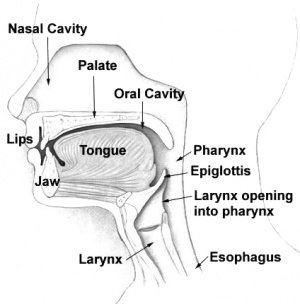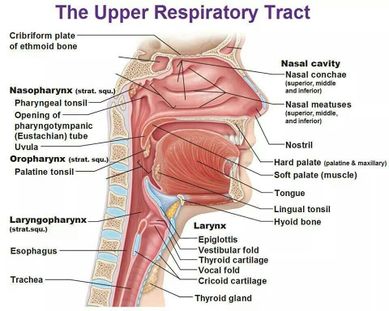Upper Respiratory Airways: Difference between revisions
No edit summary |
No edit summary |
||
| Line 9: | Line 9: | ||
== The nasal cavity == | == The nasal cavity == | ||
[[File:Upper respiratory system 2.jpg|thumb|389x389px]] | |||
The nasal cavity starts from the nostrils to the choanae, which are the openings into the pharynx. The anterior part of the nasal cavity inside each nostrils, contains the vestibule which is a dilated chamber and it is lined with coarse hairs or vibrissae with stratified squamous epithelium(which is continuous with the stratified squamous epithelium of the skin). The nasal septum that is composed of bone and cartilage divides the nasal cavity into right and left chambers called nasal fossae. The lateral wall of the fossa gives rise to three folds of tissues: the superior, middle, and inferior nasal conchae. | The nasal cavity starts from the nostrils to the choanae, which are the openings into the pharynx. The anterior part of the nasal cavity inside each nostrils, contains the vestibule which is a dilated chamber and it is lined with coarse hairs or vibrissae with stratified squamous epithelium(which is continuous with the stratified squamous epithelium of the skin). The nasal septum that is composed of bone and cartilage divides the nasal cavity into right and left chambers called nasal fossae. The lateral wall of the fossa gives rise to three folds of tissues: the superior, middle, and inferior nasal conchae. | ||
The conchae subdivide each side of the nasal cavity into series of groove-like passages (superior, middle and inferior nasal meatus). The conchae consist of mucous membranes supported by thin scroll-like turbinate bones. The conchae greatly increase the surface area of the mucus membrane over which air travel. The mucus membrane contains mucus secreting goblet cells and an extensive network of blood vessels that deliver heat and moisture. The hard palate forms the floor of the nasal cavity and separates it from the oral cavity. | The conchae subdivide each side of the nasal cavity into series of groove-like passages (superior, middle and inferior nasal meatus). The conchae consist of mucous membranes supported by thin scroll-like turbinate bones. The conchae greatly increase the surface area of the mucus membrane over which air travel. The mucus membrane contains mucus secreting goblet cells and an extensive network of blood vessels that deliver heat and moisture. The hard palate forms the floor of the nasal cavity and separates it from the oral cavity. | ||
==== '''Blood supply and Venous drainage''' ==== | ==== '''Blood supply and Venous drainage''' ==== | ||
Revision as of 11:22, 8 August 2018
Introduction[edit | edit source]
The respiratory system is structurally divided into the upper and lower respiratory system. The upper airways are the nose, nasal cavity, and pharynx while the lower airways are the larynx; trachea, bronchial tree and the lungs.
The Nose[edit | edit source]
The nose has an external portion and an internal portion inside the skull. It is formed by an upper framework of bone (made up of the nasal bones, the nasal part of the frontal bones and the frontal processes of the maxillae), a series of cartilages in the lower part, and a small zone of fibro-fatty tissue that forms the lateral margin of the nostril (the ala).
The nasal septum is usually straight at birth and it remains straight through out early childhood, but as a person ages, the septum bends toward one side. This may cause obstruction of the nasal cavity making breathing difficult. The interior part superior and posterior to the nose consist of the nasal cavity.
The nasal cavity[edit | edit source]
The nasal cavity starts from the nostrils to the choanae, which are the openings into the pharynx. The anterior part of the nasal cavity inside each nostrils, contains the vestibule which is a dilated chamber and it is lined with coarse hairs or vibrissae with stratified squamous epithelium(which is continuous with the stratified squamous epithelium of the skin). The nasal septum that is composed of bone and cartilage divides the nasal cavity into right and left chambers called nasal fossae. The lateral wall of the fossa gives rise to three folds of tissues: the superior, middle, and inferior nasal conchae.
The conchae subdivide each side of the nasal cavity into series of groove-like passages (superior, middle and inferior nasal meatus). The conchae consist of mucous membranes supported by thin scroll-like turbinate bones. The conchae greatly increase the surface area of the mucus membrane over which air travel. The mucus membrane contains mucus secreting goblet cells and an extensive network of blood vessels that deliver heat and moisture. The hard palate forms the floor of the nasal cavity and separates it from the oral cavity.
Blood supply and Venous drainage[edit | edit source]
The upper part of the nasal cavity receives its arterial supply from the anterior and posterior ethmoidal branches of the ophthalmic artery; a branch of the internal carotid artery.
The sphenopalatine branch of the maxillary artery is distributed to the lower part of the cavity and links up with the septal branch of the superior labial branch of the facial artery on the antero-inferior part of the septum. It is from this part, just within the vestibule of the nose, that epistaxis occurs in some 90% of cases.
A sub mucous venous plexus drains into the sphenopalatine, facial and ophthalmic veins.
Nerve supply[edit | edit source]
The olfactory nerve from the nasociliary branch of the trigeminal nerve supplies the specialized olfactory zone of the nose, which occupies an area in the uppermost parts of the septum and lateral walls of the nasal cavity.
The septum is supplied majorly by the nasopalatine nerve, derived from the trigeminal nerve via the pterygopalatine ganglion.
The lateral wall is innervated in the region of the superior and middle conchae, by the lateral posterior superior nasal nerve. The inferior concha receives branches from the anterior superior alveolar nerve (arising from the maxillary nerve in the infra-orbital canal) and from the anterior (greater) palatine nerve (derived from the pterygopalatine ganglion). The anterior part of the lateral wall, in front of the conchae, is supplied by the anterior ethmoidal branch of the nasociliary nerve.
The anterior ethmoidal nerve innervates the cartilaginous tip of the nose on both its inner and outer aspects.
The floor is supplied in its anterior part by the antero-superior alveolar nerve and posteriorly by the anterior (greater) palatine nerve.
The vestibule receives terminal fibres of the infra-orbital branch of the maxillary nerve, which also supplies the skin immediately lateral to, and beneath, the nose.








